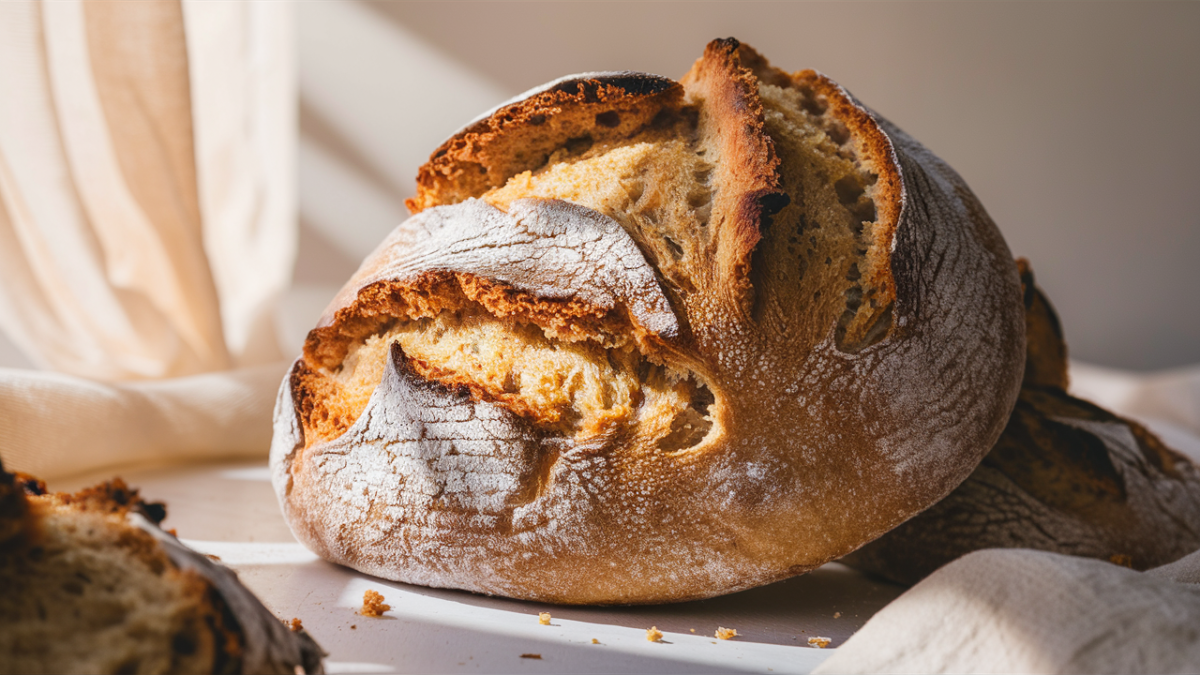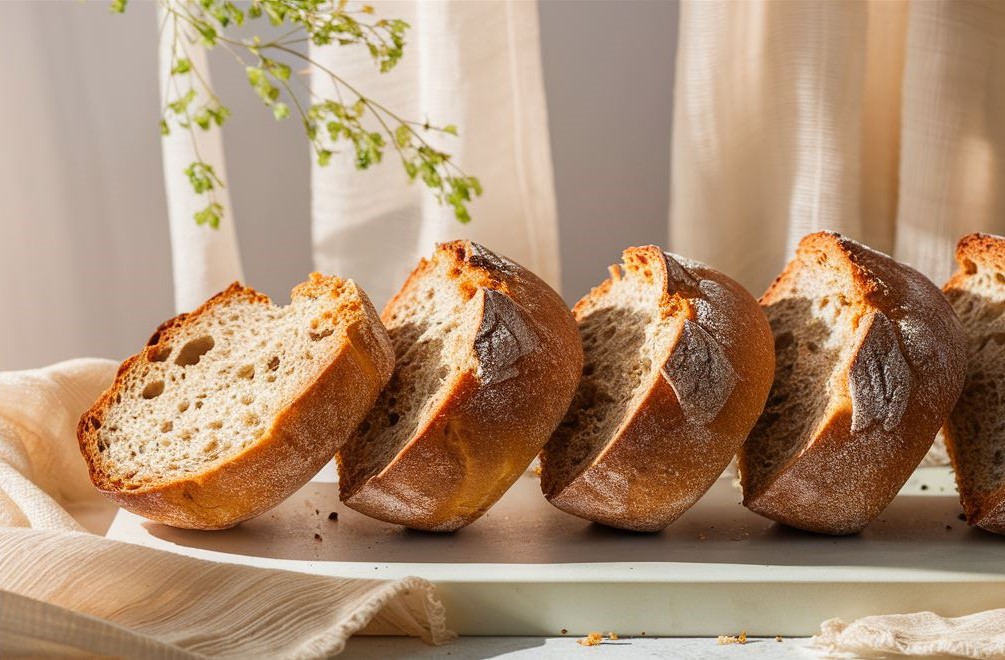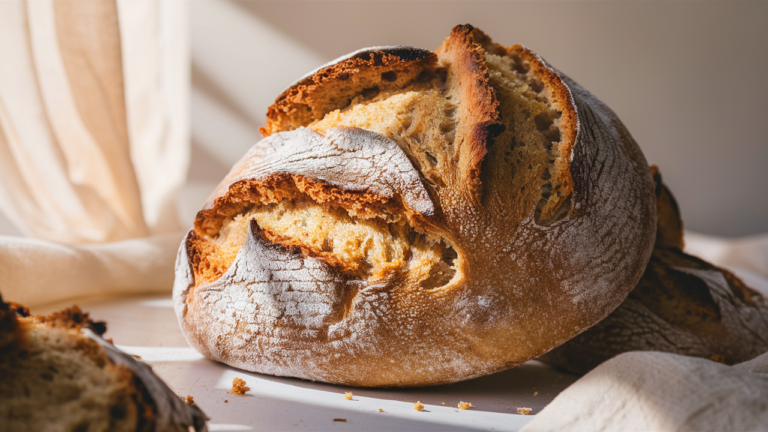Have you ever thought about making sourdough bread without gluten? Get ready to be amazed, as I show you how to make yummy gluten-free sourdough bread at home. This guide is great for people with celiac disease, gluten intolerance, or anyone who wants healthier bread. You’ll learn to bake awesome gluten-free sourdough every time.

Main Points
- Spot the special things about flours without gluten and how they’re not like normal wheat sourdough.
- Get to know the cool stuff about dough that’s been left to sit and how it can make gluten-free bread taste and feel better.
- Figure out the key stuff you need and follow the steps to bake awesome gluten-free sourdough bread from scratch.
- Check out different recipes for gluten-free sourdough bread, including regular loaves and ones without animal products.
- Find out some handy tricks to make the sitting process work great and get that fancy bread texture everyone wants.
What is Gluten Free Sourdough Bread?
Gluten-free sourdough bread tastes great for people who can’t eat wheat. It doesn’t have the proteins that make gluten like normal sourdough does. Instead, it uses different flours and goes through a careful fermentation. This makes it a good choice for folks who want gluten-free bakery stuff and healthy bread.
How Gluten-Free Is Different
What makes gluten-free sourdough special is that it doesn’t have the gluten proteins you find in regular sourdough. Bakers use flours like rice, almond, or buckwheat to bake bread that’s yummy and okay for people who have trouble with gluten.
Cool Things About Fermented Dough
The fermentation process plays a big role in making gluten-free bread. It changes the dough to make it taste better, feel softer, and be easier on your stomach. This way of gluten-free baking has gotten a lot of people who like artisan bread excited.
“Gluten-free sourdough bread is a real game-changer for people looking for a tasty option instead of regular wheat bread. The fermentation process opens up a whole new world of flavor and texture making it a pretty cool wheat alternative in the world of bakery products.”
Benefits of Gluten Free Sourdough Bread
If you’re on a celiac diet or have dietary restrictions gluten-free sourdough bread is a top pick. It’s baked with whole grain and ancient grain flours. These flours pack a punch of fiber, vitamins, and minerals.
The sourdough-making process makes the bread easier to digest. It breaks down tricky parts. This means it’s gentler on the tummy for folks with celiac disease or gluten intolerance.
Plus, baking gluten-free bread is a healthy way to make bread. It creates a yummy loaf that’s allergen-friendly. People with food issues can munch on fresh bread without stressing about bad reactions.
| Benefit | Description |
|---|---|
| Nutrient-Dense Ingredients | Gluten-free sourdough is often made with whole grain and ancient grain flours. These flours give more fiber, vitamins, and minerals. |
| Improved Digestibility | The fermentation process breaks down hard-to-digest parts. This makes the bread easier to digest for those with celiac disease or gluten intolerance. |
| Allergen-Friendly | Gluten-free sourdough bread is a safe and tasty choice for people with various dietary restrictions and food sensitivities. |
Key Ingredients
To make gluten-free sourdough bread, you need a special blend of ingredients. You should know about different flours and how to create a strong gluten-free sourdough starter. This is vital to get the right feel and flavor in your homemade bread.
Whole Grain and Ancient Grain Options
Since regular wheat flour is off the table, you’ve got lots of whole grain and ancient grain choices. These can make your sourdough more interesting and complex. Here are some good options:
- Brown rice flour
- Oat flour
- Buckwheat flour
- Quinoa flour
- Millet flour
- Teff flour
These flours don’t have gluten, but they do add good stuff to your sourdough bread. They also give it a special taste and feel. Mix and match to see what you like most.
How to Make a Gluten-Free Sourdough Starter
The key to awesome gluten-free sourdough bread lies in how it ferments. To make the bread rise and taste great, you need a strong sourdough starter. Making one might look tricky, but with some patience and love, you can create a gluten-free starter from the ground up.
To help your starter grow, feed it on a regular basis. Before long, you’ll have a solid method to get your gluten-free sourdough to puff up .
“To make great sourdough bread, you need to focus on how it ferments. Growing a strong sourdough starter is super important, because it helps the bread rise and gives it that special sourdough taste.”
Step-by-Step Guide to Baking Gluten Free Sourdough Bread
Making gluten-free sourdough bread might look tough, but it’s not as hard as you’d think. This guide will show you how to bake a gluten free bread recipe in your own kitchen. We’ll cover everything from mixing the dough to putting it in the oven.
Let’s start with artisan baking and fermented dough. These play a big role in making a yummy gluten-free sourdough bread. Take your time and allow the dough to ferment so it gets flavorful.
- To start, take a big bowl and mix up your beginner gluten free sourdough recipe stuff. You’ll need flour, water, and sourdough starter to make a rough dough.
- Give the dough a quick knead for a couple minutes. After that, let it sit and grow in a cozy damp place for 8-12 hours. It should puff up.
- Now, shape your dough into a round loaf. Put it in a baking dish or Dutch oven with some parchment paper on the bottom.
- Let the dough rise for another 2-3 hours until it’s all puffy and good to bake.
- Crank up your oven to 450°F. Stick the dough in there and let it bake for about 25-30 minutes. You’ll know it’s done when the crust looks golden and feels hard.
- Once it’s ready, pull the bread out and pop it on a wire rack to cool down. After that, you can cut it up and dig in.
Gluten Free Sourdough Bread Recipe
This easy-to-follow recipe yields a deliciously tender loaf with a crusty exterior that even those not following a gluten-free diet will adore. Packed with all the sourdough tang you love and none of the gluten you don’t, this bread is a must-try for any home baker. Dive into the world of gluten-free sourdough baking and impress your friends and family with your baking prowess!
- Total Time: 12 hours 20 minutes
- Yield: 1 loaf 1x
Ingredients
- Starter:
- 1 cup gluten-free sourdough starter (active)
- 1 cup water
- 1 cup gluten-free flour blend
- Dough:
- 2 cups gluten-free flour blend
- 1 ½ teaspoons salt
- 1 teaspoon gluten-free baking powder
- ½ cup water (adjust as needed)
- 2 tablespoons olive oil
- 1 tablespoon honey (optional for a slight sweetness)
Instructions
- Prepare the Starter:
- Mix the sourdough starter, water, and gluten-free flour in a large bowl. Cover loosely and let it ferment at room temperature for about 12 hours until bubbly.
- Make the Dough:
- To the fermented starter, add the gluten-free flour, salt, baking powder, water, olive oil, and honey. Mix until well combined. The dough should be sticky; adjust water as needed.
- Cover the bowl with a damp cloth and let it rise for about 2 hours in a warm place until it slightly puffs up.
- Shape and Proof:
- Transfer the dough to a parchment-lined bread pan. Smooth the top with wet hands or a spatula. Cover and let it proof for another hour.
- Bake:
- Preheat your oven to 400°F (200°C). Place the bread in the oven and bake for 50 minutes or until the crust is golden and sounds hollow when tapped.
- Remove from the oven and let cool in the pan for 10 minutes. Transfer to a wire rack to cool completely.
Notes
- Flour Selection: Use a high-quality gluten-free flour blend that includes xanthan gum for the best texture.
- Hydration: Gluten-free flours absorb more liquid. Adjust the water in the recipe based on the dough’s consistency.
- Proofing Time: Gluten-free doughs do not rise as much as wheat-based doughs; don’t expect a significant rise.
- Baking: Do not cut into your bread until it has completely cooled to avoid a gummy texture.
- Prep Time: 20 minutes
- Category: Bread
- Method: Sourdough Fermentation
- Cuisine: American
Nutrition
- Calories: 150 kcal
- Sugar: 1g
- Sodium: 300mg
- Fat: 3g
- Fiber: 3g
Keywords: #GlutenFreeBaking #SourdoughBread #HealthyEating #HomeBaker #GlutenFreeLife #Foodie #BreadLovers #HomemadeBread #CeliacFriendly
This guide will help you improve your bread baking skills. You’ll love your homemade, artisan-style loaf!
Tips to Perfect Your Gluten Free Sourdough Bread
To bake gluten-free sourdough bread takes time and practice. Over the years, I’ve picked up some tricks to help you make the best gluten free sourdough bread. The secret lies in getting the fermentation process right.
Getting the Hang of Fermentation
Fermentation plays a big role in giving gluten free sourdough bread its tangy flavor and chewy texture. Here are some pointers for successful fermentation:
- Keep the temp right: For gluten free sourdough to ferment well, you want it between 70-85°F. A proofing box or oven with the light on works great for this.
- Watch how long it takes to rise: During the first rise, keep an eye on your dough. It should get twice as big, which can take 8-12 hours. This depends on your starter and how warm it is.
- Know how gluten-free flour works: It’s not the same as wheat flour. Don’t rush it – let the dough take its time to rise.
- Make it taste better with more rises: After the first rise, you can put it in the fridge for 12-24 hours to make it taste more sour. This is called a cold ferment.
Getting good at making things ferment will help you bake the best gluten free sourdough bread you’ve ever eaten.
“The true heart and soul of sourdough bread lies in the fermentation process. With patience and attention to detail, you can create a textured flavorful loaf that’s both gluten-free and satisfying.”
Gluten Free Sourdough Bread Recipes
Want to try making gluten-free sourdough bread at home? I’ll show you two yummy recipes. First, we’ll make a normal gluten-free sourdough loaf great for sandwiches and toast. Then, we’ll look at a vegan one, without any animal stuff, for people who need to avoid those things too.
Classic Gluten Free Sourdough Loaf
This gluten-free sourdough loaf is a bread lover’s wish come true. It mixes gluten-free flours to create an awesome texture and a sour taste. You can use it to make toast, sandwiches, or just munch on it as is. This recipe will soon be a hit in your gluten-free kitchen.
Vegan Gluten Free Sourdough Bread
If you’re vegan or try to avoid allergens, this gluten-free bread is just right for you. It doesn’t have any animal stuff in it but still tastes rich and has that chewy feel of regular sourdough. Serve it with some soup or use it to make sandwiches and your guests will be impressed.
| Recipe | Dietary Restrictions | Key Ingredients |
|---|---|---|
| Classic Gluten Free Sourdough Loaf | Gluten-free | Gluten-free flour blend, sourdough starter, water, salt |
| Vegan Gluten Free Sourdough Bread | Gluten-free, Vegan, Allergen-friendly | Gluten-free flour blend, sourdough starter, water, plant-based milk, maple syrup |
Serving and Storing Gluten Free Sourdough Bread
Now that you know how to make gluten-free sourdough bread, let’s chat about how to serve and store it. These tips will help you enjoy your better-for-you bread choices, whether you’re eating it at home or sharing it with friends.

Serving Gluten Free Sourdough Bread
Gluten-free sourdough bread tastes good with lots of toppings and sides. You can put creamy avocado tasty hummus, or your favorite cheese on it for a snack or small meal. The sour flavor also goes with sweet jams, honey, and nut butters.
To make a bigger meal, you can add cooked veggies roasted meats, or a fried egg on top. It’s a flexible bread that anyone can eat and enjoy.
Storing Sourdough Bread
- Store your fresh gluten-free sourdough bread at room temp. Wrap it in a clean towel or bag. This keeps the crust crunchy and the inside soft for 3-4 days.
- To store it longer, cut the bread into slices and put it in the freezer in a container or bag. Frozen bread stays good for 2-3 months. Just let it thaw out or pop it in the toaster when you want to eat it.
- Don’t put your gluten-free sourdough in the fridge. The dry air in there makes it go stale and get hard faster.
Follow these tips to make your gluten-free sourdough bread last longer. It’s a healthy option for your diet and great to share with people who have special food needs.
Trying Out Different Gluten Free Sourdough Breads
Making gluten-free sourdough bread is cool and gives you a sense of achievement. You can do more than just make the usual loaf. You have the chance to create your own version of gluten-free sourdough. To do this, try using different whole grain and old-school flours. You can also add stuff like nuts, seeds, and dried fruits to make it your own special recipe.
Experimenting with different flours can help your gluten-free sourdough to be unique. Whole grain alternatives like brown rice, millet, or buckwheat flour can give your bread a rich taste and a hearty feel. Ancient grains like teff, quinoa, or sorghum flour can add special nutty flavors and tons of nutrients to your sourdough.
Gluten-free sourdough has the flexibility to adapt if you have allergen-friendly or dietary restrictions. You can bake loaves without nuts, seeds, or even make vegan versions by picking the right stuff and tweaking your recipe.
“Gluten-free sourdough bread has opened up a whole new world of baking for me to explore. I enjoy trying out different flours and mix-ins to make unique and tasty loaves that are all my own.”
Gluten-free sourdough gives you room to be inventive in the kitchen. It’s great for building up your cooking chops or catering to specific diets. With gluten-free sourdough, you have the chance to try out tons of flavors and textures.
Gluten Free Sourdough Bread for Special Diets
It works great for folks with special diets. People with celiac disease, vegans, and those doing paleo or low-FODMAP diets can eat it. You can enjoy its yummy taste and health perks without breaking your diet rules if you get a bit creative and make some tweaks.
Helping People with Celiac and Gluten Issues
Gluten-free sourdough is awesome for people with celiac disease or gluten problems. You can make a gluten-free loaf by using safe flours like rice, buckwheat, or almond, and letting it ferment well. This lets people on a celiac diet enjoy sourdough’s rich texture and satisfying inside.
Vegan and Plant-Based Options
You can make gluten-free sourdough vegan and plant-based too. Just use non-dairy milk or yogurt instead of dairy, and flax or chia seeds to replace eggs. This gives you a vegan-friendly sourdough that’s yummy and fills you up like the regular kind. Vegans and people with allergies will love this option.
Paleo and Low-FODMAP Adaptations
People who follow paleo or low-FODMAP diets can make gluten-free sourdough that fits what they eat. They can use flours like almond or cassava that work for paleo diets. They should also pick ingredients that are low in FODMAPs. This lets them enjoy the nice smell and warmth of sourdough without tummy troubles.
Gluten-free sourdough bread has a big impact on folks with different food needs. You can change it to work for celiac, vegan, paleo, or low-FODMAP diets. This means you get to eat yummy sourdough and not worry about your health.
Conclusion
In this guide, we took a deep look into gluten-free sourdough bread. We got to know about its special perks and how to bake yummy loaves at home. This bread is a solid pick for anyone who wants to eat healthier.
If you’re baking for yourself or others gluten-free sourdough is a great choice. You’ve now got the know-how to make your own gluten-free sourdough in your kitchen. Enjoy the full flavors and nice textures of this fancy bread.
Picking gluten-free sourdough lets you enjoy fancy baking while staying healthy. I say you should keep trying out this good-for-you bread option. Find new ways to feed your body well and make your taste buds happy.
FAQs
What’s different about gluten-free sourdough bread compared to regular sourdough bread?
Gluten-free sourdough bread doesn’t contain proteins that form gluten like regular sourdough does. It uses different flours such as rice, millet, or old-school grains instead. To get a texture and flavor similar to traditional sourdough, this bread has to ferment for a longer time.
How can eating gluten-free sourdough bread be good for you?
People with gluten allergies or those who can’t handle gluten well can eat gluten-free sourdough. It’s made with whole grain and old-school grain flours, so it has more fiber, vitamins, and minerals. Because it’s fermented, your body can digest it more .
What do you need to make gluten-free sourdough bread?
You’ll want some whole grain and old-school flours like brown rice, millet, or teff to make gluten-free sourdough. You can’t forget a gluten-free sourdough starter – it’s super important. You’ll also need water, salt, and maybe some xanthan gum or psyllium husk to hold everything together.
How can I start a gluten-free sourdough culture?
To begin a gluten-free sourdough culture takes a while. First, mix gluten-free flours with water. Then, keep feeding it and look for it to grow. You gotta be patient until it becomes a strong culture before you use it to make bread.
How can I make my gluten-free sourdough bread ferment better?
To get the fermentation right in gluten-free sourdough, you need to pay attention to a few things. Keep an eye on the temperature and humidity. Don’t rush it – give it time. Watch your dough . If you do these things, your bread will taste great and rise well.
Is it possible to make gluten-free sourdough bread without animal products?
! You can make vegan gluten-free sourdough by swapping out animal stuff for plant-based options. Try using nut or seed butters to bind things together. Aquafaba works too. You could also use flax or chia seeds. Pick the right flours and ingredients, and you’ll end up with a bread that’s both tasty and free from common allergens.
How can I serve and store gluten-free sourdough bread?
Cut your gluten-free sourdough right before you eat it to get the best flavor and feel. You can munch on it by itself, put stuff on top, or make sandwiches with it. To keep it fresh, wrap it in a clean cloth or put it in a paper bag at room temp for 3-4 days. If you want to store it for a long time, slice it up and stick it in the freezer for up to 3 months.
Other Recipes You Might Like Also
Craving something savory? Our Easy Delicious Salmon Cakes are a perfect addition to your meal.
Indulge in dessert with our Strawberry Cheesecake Overnight Oats, a delightful combination of cheesecake flavors and healthy oats.
Complement your gluten-free sourdough bread with our Refreshing Seafood Salad, perfect for a light and tasty meal.


